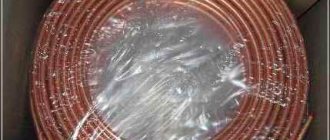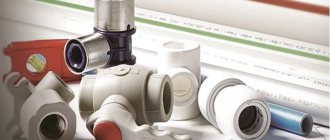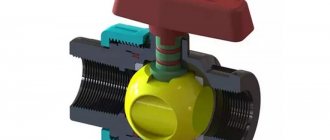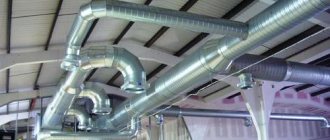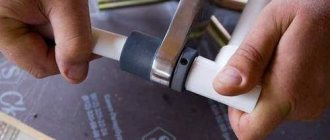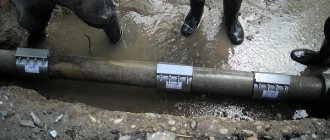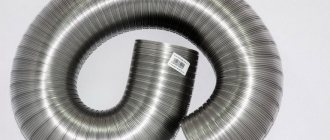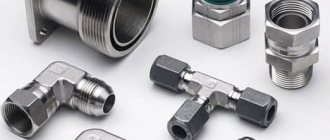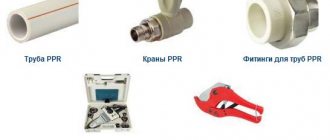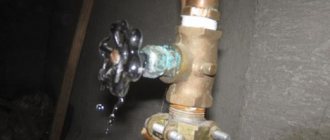Fittings for polyethylene pipes differ from similar units for metal pipelines not only in the type of structural material of the housing (it is made of the appropriate type of plastic). The main pipes of such fittings are designed for a completely different technology for installing the device in the pipeline. And in this article we will look at the mentioned design features of shut-off and control valves for polyethylene pipes.
Advantages and disadvantages
The advantages of shut-off valves include:
- small dimensions;
- resistance to pollution;
- simplicity of design;
- sufficiently high throughput;
- anti-corrosion coating that prevents rusting of body parts;
- ability to withstand the required pressure and temperature;
- ease of use.
The disadvantages of this type of device are:
- the need for regular maintenance;
- rapid wear of sealing materials.
Installation technology
The installation of couplings of various types during pipeline installation has several similar features:
- The edges of the pipe to which the fitting will be joined must be cut strictly perpendicular to the axis to ensure a tight fit of the surfaces to each other.
- For installation, you only need an adjustable wrench, additional sealing means and components suitable for the diameter.
The threaded method of connecting fittings implies the presence of a counter thread on the pipe. If there is none, you will have to use a tap and a die. Then the entire structure is joined and the coupling is screwed onto both pipes at the same time.
The American is installed in the following sequence: a crimp nut and an O-ring are put on the pipe, then its edge is inserted into the fitting and the structure is tightened with a wrench. At the end, both hexagons are turned simultaneously to ensure a strong connection.
Press couplings are installed differently: a pipe cut perpendicularly is inserted into a sleeve and pressed into place.
Kinds
The shut-off valves of the water supply system include the following devices:
- Cranes are devices with a locking or regulating part in the form of a rotating body or its segment. When triggered, it rotates around its own axis by 90 degrees and completely stops the flow of liquid or turns to a smaller angle, partially blocking the flow and regulating its strength. The taps are made of brass, stainless steel, bronze or plastic. According to the shape of the shut-off element, taps are:
- spherical - shut off the water by rotating a spherical valve in the body cavity;
- cork - have a locking element in the form of a cork, which, when the handle is moved, is lowered into the saddle.
Depending on the design of the body, cranes are divided into:
- direct-flow - used for placement on straight sections of water supply lines;
- corner - mounted in places where communications branch, simultaneously performing the function of a corner fitting.
- Valves (valves) are a type of shut-off and control valves with a locking element moving parallel to the axis of the water flow. Typically used for installation on relatively small diameter pipelines. According to the design of the shut-off element, valves are divided into products with:
- disc (spool);
- conical shutter.
According to the method of ensuring the tightness of the junction of the body neck with the lid, valves are divided into:
- stuffing box;
- membrane
To equip home water supply systems, safety devices are used - spring-type check valves with a nominal diameter of 15 to 50 mm. Water flowing through such a product under a certain pressure affects the locking part and presses the spring, which holds it in the “closed” position. After compressing the spring and opening the passage, the liquid begins to flow freely through the check valve in the desired direction. When the pressure of the fluid flow in the pipeline drops or the direction of water movement changes, the shut-off element returns to its original position using a spring mechanism. By functioning in this way, this device is able to prevent the occurrence of unwanted reverse movement of liquid in the water supply system.
- Valves. Such devices stop the movement of liquid flow by moving (rotating) the valve body in the direction perpendicular to its movement.
They are made from an alloy of steel or cast iron, with a straight-through or narrowed bore design. According to the shape of the valve, valves are classified into:
- wedge - the shutter has the shape of a wedge, which, when the device is activated, fits tightly between the body saddles located at a slight angle to each other;
- parallel - with a valve consisting of two disks and sealing planes of the seats, parallel to each other.
- Dampers (butterfly valves). Wafer valves are installed on pipelines supplying water, which can withstand pressure up to 1.0 MPa.
Such products are equipped with a sealing gasket made of dense rubber, through which the required tightness characteristics are achieved. Manually controlled models are placed on the pipeline in any position, and models with a remote control type are mounted with the electric drive upwards.
- Coarse filters. Water is purified from impurities with a particle size of 5 to 50 microns before it enters the tap/mixer, meter, washing machine, dishwasher and other household appliances.
In addition to a replaceable filter mesh, the filter design may include a check valve that reduces pressure and one or two pressure gauges that measure pressure before and after the mesh filter.
For internal water supply networks, water taps are used - taps, mixers and drain fittings - toilet float valves, plungers, siphons, etc. It is customary to install an air aerator on the water tap. It saturates the water with oxygen, thus helping to purify it from impurities of sand and some heavy metals.
Types of coupling fastenings
Coupling fastenings are simple. They do not require additional fasteners, as is the case with the installation of flanges, for which you need to use bolts and nuts.
The coupling connection of pipeline fittings is carried out by:
- inserting the ends of the pipe into the socket;
- gluing adjacent surfaces;
- by screwing a thread;
- using diffusion welding.
The first type of connection implies the absence of pressure in the system. It is used to connect sewer and drainage sections. Tightness is ensured by a dense rubber ring with an edge protruding towards the center. Additionally, you can treat the edge with silicone or glue the surface with construction tape.
Adhesive or welded joints are used when laying plumbing and heating systems. The process is carried out in this way: an adhesive is applied to the surface of the pipe and fitting, then they are combined and the time required for the substance to set and harden is maintained.
The majority of threaded connections are used not for connecting work, but when installing shut-off and control valves with manual drive or automatic control.
The latest method is made possible thanks to an electrode installed inside the coupling and a material that easily melts under the influence of current. It is enough to connect 2 elements of the main line and connect the wires, and melting occurs. After this, the transmission of electricity is stopped and they wait for the material to harden, simultaneously soldering the surfaces and ensuring complete tightness.
Tips for choosing
The choice of fittings depends on several factors, including:
- indicators of working pressure and temperature of the medium in the pipe;
- location on the pipeline;
- frequency of actuation or switching cycles;
- the cross-sectional size of the nominal diameter of the connection pipes and the type of connection;
- material of body parts and presence of anti-corrosion coating;
- permissible level of hydraulic resistance;
- having a throughput capacity of the appropriate volume;
- geometric parameters of the product.
For water supply systems in the residential sector, steel alloy fittings are most often used, especially in cast or forged body designs. The material is able to withstand fairly high pressure and temperature, water hammer and vibration. The products are quite affordable, although not the cheapest.
In systems with more powerful and severe loads, cast iron fittings are installed.
Bronze and brass are used for the manufacture of devices operating in systems with low pressure and temperature.
Plastic products are considered the least reliable, but in some cases their use is allowed.
As with the purchase of any other product, many people choose the most inexpensive products. But you should not focus only on their cost, since a truly high-quality and reliable device will not be too cheap.
It is also advisable to choose models from trusted manufacturers and in specialized stores that can provide guarantees of the quality and reliability of their products. After all, the functioning of the system and its durability depend on the correct choice of shut-off valves for the water supply system.
Price of shut-off valves wholesale and retail
The cost of constipation directly depends on its characteristics, the materials used, as well as the volume of purchases. When purchasing devices in Moscow and the region, you should carefully select suppliers. It is best to pay attention to companies with extensive experience in this field.
So, in the catalog presented on our website, you can find many types of shut-off pipeline valves for various types of use, as well as other plumbing fixtures. Thus, in one place you can purchase plumbing equipment to create a utility project.
Our company has been on the market for more than 17 years. During this time, we were able not only to form a team and highly qualified specialists, but also to collect many advantages that every client can take advantage of:
- Wide range of products for different types of use.
- The shortest possible time for completing work.
- The best service from professionals with extensive experience.
- Opportunity to purchase quality products at the lowest price.
Placing an order for high-quality locking elements is easy. It is enough to contact the specialists of our online store by phone and express your wishes to select the right products.
Do-it-yourself fittings installation
Installation of locking products is carried out in different ways: welding, threaded or using flanges.
Required tools and equipment
The set of necessary tools and equipment is selected depending on the type of connection between the device and the pipeline.
To install fittings with a threaded connection type, it is sufficient:
- an adjustable wrench or a wrench of the appropriate size;
- thread cutting devices;
- consumables for sealing a threaded connection (ordinary linen thread or FUM tape);
- gaskets, which are included in the kit for almost all models.
The flange connection is made using:
- torque wrench;
- sealing gasket;
- mounting bolts.
To install welded fittings, you need to stock up on:
- equipment for welding work;
- a sheet of sandpaper;
- Bulgarian
Installation of fittings by welding
To connect the shut-off device, it is necessary to shut off the water supply to the apartment completely or turn off a separate line using the nearest working tap. Then, using a grinder, cut out the section of the pipe where the product will be installed, and sand the ends on both sides with sandpaper. Next, the new device is welded with two seams along the entire circumference of the pipe.
Cutting the pipe and welding the valve must be carried out using personal protective equipment: special glasses for the eyes, dielectric gloves for the hands.
Installation with threaded connection
The process of installing threaded shut-off valves consists of the following steps:
- cutting out a pipeline section and processing pipe ends;
- thread cutting;
- sealing threads with FUM tape or linen thread;
- fixing the product;
- checking the tightness of the connection area.
The process of sealing threads when installing shut-off valves is demonstrated in the video:
Installation of fittings on flanges
Installation of shut-off devices on flanges is a detachable type of connection and is mainly used for placement on industrial water supply pipelines. Connecting the ends of pipes using flanges with your own hands on a household system is quite difficult, since it will require welding of special rings to secure the fittings. If the rings are already welded, then the installation of flanged devices is carried out as follows:
- install a sealing ring between the flange and the ring at the end of the pipe to ensure the tightness of the connection;
- secure the product with the fastening bolts with which it was equipped during production.
What it is?
Pipeline connecting fittings come in several types, some of them are mounted by welding, others are fixed with a fitting, plastic products are soldered. But the threaded design has remained the most common for many decades. Such a coupling, angle, tee or shut-off valve is equipped with female threaded fittings that simply screw onto the end of the pipe.
The coupling connection of the reinforcement is reliable. Its tightness is achieved by winding flax tow, fluoroplastic sealing material or a special viscous lubricant onto the thread turns.
There are PVC couplings, the connection of which is carried out not only by threading, but also by pressing.
Features and purpose
Coupling fittings are designed to connect parts of pipes made of different materials in the event of replacing a section of the main line, installing an additional fitting, branching the system or turning it, in some cases for installing a blind end with the possibility of extending the pipeline in the future.
The peculiarity of this element is its versatility. The product can be used in systems made of metal, metal-plastic and plastic pipes. Regardless of the material, maximum tightness and durability of the joint is ensured.
Couplings are available in various configurations and sizes, which allows you to choose the most suitable option in each individual case. In this case, installation is carried out quickly and without the use of special tools (except for cases when it is necessary to cut threads on the pipe).
Coupling fittings are used in everyday life, in the gas and oil industries, when laying cold and hot water supply lines, and for installing heating mains.
Operating principle and design
Coupling fittings are a piece of pipe with connecting pipes on both sides, equipped with internal threads (in the case of metal products) or a rubber sealing gasket (in plastic parts).
Inch threads on couplings are formed by rolling, cutting or stamping. Moreover, due to the fine pitch, the height of the teeth does not affect the diameter of the pipeline in any way. To ensure quick screwing of the product from the outside, the ends form a hexagon for keys. Apart from this tool, you won't need anything else.
The design of the American coupling eliminates the need to rotate the entire part. The pipes in it are replaced with union nuts. For tightness, the product is equipped with a firmly fixed gasket in the form of a ring on the outer surface of the housing.
PVC couplings are used when laying sewers, water pipes, organizing irrigation, etc. They can be either threaded or equipped with a rubber seal for a tight connection with the outer surface of the pipe.
Expert advice
When installing shut-off valves, experts recommend observing the following requirements:
- Do not apply too much force when tightening the bolts to prevent the appearance of microcracks on the product body or strong clamping of the rubber gaskets.
- The devices should be installed in accordance with the direction of the arrow on the device body, which shows the correct direction of water movement.
- It is forbidden to carry the valve by holding the stem.
- Before installing the device, be sure to clean its parts from possible contamination by rinsing with soapy water.
- When welding pipes, the fittings must be in the “open” position.
- Products should not be allowed to fall, as they may receive external damage, which will quickly lead to corrosion.
- It is advisable to install filters of varying degrees of purity in front of all plumbing and household appliances.
Features of application
The most widespread use of coupling fittings is when modifying already installed pipeline systems. This includes creating branches, turns, installing functional elements in the form of a tap, valve or stopper.
There is a demand for equipping such a collapsible joint in places where the main line and the units and devices installed on it are constantly being replaced or reconstructed. This allows you to shut down at any time without dismantling the pipes.
The most recommended pipeline diameter is no more than 40 mm in areas with open access. When laying underground pipelines, it is better to use fittings that are welded or fixed with flanges.
Type of fittings by type of connection to the system
Reinforcement is distributed according to many characteristics. The method of fastening is important. This takes into account the type of thread of the product, the required tightness, and more.
Threaded connection
Mainly used for large pipes. The thread diameter is always indicated on the equipment. The connection can be attached using a thread spanner. To enhance the tightness of the system, various substances can be used. Typically used for valves, distributors, gate valves.
Among the advantages, it should be noted the ease of installation and the relative low cost of the technology. Disadvantage: inability to use in pipelines with high pressure.
Union connection
Used for thin pipes. The thread is on the outside. This type of connection allows you to connect measuring instruments. Used in specific conditions.
Welded joint
Welding is used in cases where liquid hazardous to health flows through pipes. It is necessary to ensure a high degree of tightness of the system. The seam should be strong enough to reduce the chance of leakage.
The following welding methods are distinguished:
- the coupling point is additionally secured with a ring;
- the seam is made from the outside.
This work allows us to ensure the required degree of tightness of the system. Before installation, it is necessary to process the ends of the pipes. The fastening method is characterized by low cost and ease of execution. Installation of the structure requires specialists.
Shut-off valves for toilet flush barrel
It is the use of special sealed elements that ensure the functioning of the drain barrel. The strength and reliability of the plumbing fixtures depends on the reliability of the fastening.
Conditions for the production of fittings
The material used to manufacture pipeline fittings is determined by its future area of application. If the system (or section of the system) will operate at pressures up to 1.6 MPa, ductile cast iron is used; if more - steel. For small cross-section pipelines, high-quality copper alloys are used, which prevent corrosion of elements and sticking of fittings to the pipes.
It should be noted that the production of reinforcing elements is a complex and high-tech matter, and therefore must be carried out using special industrial equipment.
To produce products you need:
- bake;
- special purpose press;
- diagnostic machine;
- table on which assembly is carried out;
- lathe;
- drilling machine;
- conveyor;
- air compressor for painting products;
- auxiliary tools and devices.
Pipeline fittings for a steam pipeline from the SOTIS company
SOTIS LLC is a reliable supplier of engineering equipment and components for heating, water supply and sewerage systems. Offering a full line of shut-off valves for steam, we guarantee the high quality of each sample. As a supplier from leading manufacturers, the company invites large and small enterprises, housing and communal services organizations, and entrepreneurs to cooperate. The price list of pipeline fittings is regularly updated and supplemented with new items. For questions regarding cooperation and orders, you can obtain information by phone. +7(495)320-03-00.
Bimetallic steam trap
The operating principle of a bimetallic steam trap is based on the temperature difference between steam and condensate.
The working body of a bimetallic condensate trap is a rod with bimetallic plates installed on it. This unit is assembled from separately bonded pairs of metal plates with different expansion coefficients. These plates are selected so that in the normal (cold) state the plates are a flat disk. As the temperature rises, the plates expand unevenly, which leads to their deformation. It is this deformation that causes the plates to bend, which in turn moves the rod a length sufficient to close the exhaust valve. That is, air and condensate calmly pass through the condensate trap. Steam hitting the working element heats it and remains in the condensate trap body.
The advantages of bimetallic condensate traps include:
- Resistance to hydraulic shocks;
- When operating bimetallic condensate traps in low temperatures, they do not require additional heating devices.
- Can be reconfigured for use at high temperatures and pressures.
But we must also remember that steam traps of this type have a slow response to changes in operating conditions: pressure and flow.
Advantages and disadvantages
Sleeve shut-off valves are characterized by:
- ability to work in systems with high operating pressure;
- high resistance to changes in operating pressure;
- ease of maintenance and repair;
- long service life;
- small working stroke;
- relatively small weight and dimensions;
- possibility of installation in any position;
- Possibility of installation anywhere in the pipeline.
The disadvantages include high hydraulic resistance and the inability to use for viscous media.
Detachable connections of polyethylene pipes
Installation of polyethylene pipes using detachable connections is carried out in two ways using compression (coupling) fittings and flange connections. The advantage of detachable connections is the ability to disassemble the pipeline for its dismantling or repair of shut-off valves and subsequent reassembly.
Compression fittings, or compression fittings, are used to connect only polyethylene water pipes with a diameter of 20 to 110 m. The principle of connection is to crimp the pipe with a special clamping sleeve with chamfers on it that cut into the pipe and prevent disconnection of the connecting unit. Connection using compression fittings ensures the operation of the unit up to 16 atmospheres with pipe diameters from 20 to 63 mm and 10 atmospheres for pipes with a diameter of 75 - 110 mm.
This method of connecting pipes is good because it does not require knowledge of special skills or the use of equipment. Compression fittings are quite widely used for connecting pipes in irrigation systems or in private construction. They can be easily assembled and just as easily disassembled, for example, at the end of the summer season.
Installation of polyethylene pipes - Compression fittings
Installation of polyethylene pipes using flange connections can be carried out on pipelines with a diameter of 50 to 1600 mm. This method is widely used when connecting polyethylene pipes to steel pipelines and in places where the pipeline is connected to control valves. The flange connection consists of two parts: the flange itself and a polyethylene sleeve under the flange, which is welded at the end of the pipe and prevents the flange from slipping off the pipe.
Installation of polyethylene pipes - Flange connection
Manufacturing technology and materials
In the production of locking devices, several groups of materials are used, each of them performs specific tasks: materials for the manufacture of body parts, ensuring the tightness of connections between components and parts, reducing the friction force between them. The basis for the manufacturer's choice of the housing metal alloy is the characteristics of the working environment, corrosion resistance, strength and casting properties.
Brass valves
A type of shut-off and control devices used to turn on, turn off and regulate the flow of liquid in water supply systems of various objects. For the manufacture of body parts, brass of the LTs40Sd brand is used, which gives them:
- high corrosion resistance;
- resistance to sudden temperature changes;
- ability to work in systems with high operating pressure.
Cast iron valves
One of the most common body materials for shut-off valves is cast iron.
It is a heavy material with a high carbon content and has the following advantages:
- good hardness;
- low price;
- excellent casting characteristics;
- good anti-corrosion properties.
The downside is the increased fragility of the material and poor frost resistance, as a result of which the cast iron coupling valve can be damaged by impact, tensile loads or sub-zero temperatures.
In the production of shut-off valves, the following types of cast iron alloy are used:
- gray cast iron is the most fragile type of material;
- malleable - has greater toughness and strength with significantly less fragility;
- high-strength (with the inclusion of spherical graphite in the alloy) - is the most durable alloy, used for the manufacture of more critical devices.
To increase corrosion resistance, cast iron body parts are often coated on the inside with a layer of rubber, plastic, or painted with enamels.
Steel devices
Steel is widely used for the manufacture of body parts due to its ductility, high casting properties and ease of machining. Compared to cast iron alloy, steel is a fairly strong material, despite its lower hardness. A steel coupling valve is also inexpensive.
When special alloying elements (cobalt, manganese, chromium, vanadium and others) are added to the composition, a material is obtained for the manufacture of reinforcement that is more resistant to destruction, with increased strength characteristics, and resistant to high temperatures.
Types of alloy steels are stainless steel and heat-resistant steel. The first type of material is used for the production of devices resistant to all types of corrosion, the second - for the production of fittings operating in systems with high ambient temperatures.

